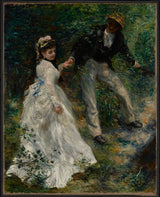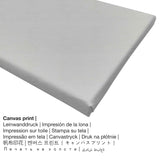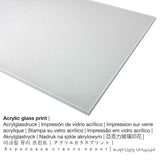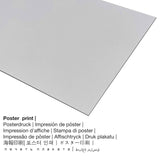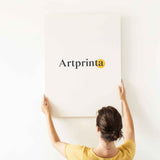Pierre-Auguste Renoir, 1870 - ije - ọmarịcha akwụkwọ nka
Ụtụ gụnyere. Mbupu gbakọrọ na ndenye ọpụpụ.
Họrọ ihe ngwaahịa gị
N'ime ndetu ndetu dị n'akụkụ onyinye ngwaahịa ị nwere ike họrọ ihe yana nha dabere na mmasị gị. Ka ị kwekọọ n'ihe ị chọrọ nke ọma, ị nwere ike họrọ n'ime nhọrọ nhazi ngwaahịa ndị a:
- Mbipụta iko acrylic (nke nwere ezigbo mkpuchi iko): A glossy acrylic glass print, often labelled as a print on plexiglass, will convert your favorite original work of art into brilliant décor.
- Kwaaji: The printed canvas, which shall not be confused with a canvas painting, is an image printed on a UV direct printing machine. It makes the particular look of three-dimensionality. Your canvas print of your favorite work of art will let you turn your very own art print into a large artwork like you would see in a gallery. A canvas print has the great advantage of being relatively low in weight, which implies that it is quite simple to hang your Canvas print without any wall-mounts. Canvas prints are suited for all kinds of walls.
- Mbipụta nke aluminom: Aluminium Dibond prints are metal prints with a true effect of depth. For your Print On Aluminum Dibond, we print your artpiece onto the aluminium surface. The white and bright parts of the original artpiece shimmer with a silk gloss, however without glare. The print on aluminium is one of the most popular entry-level products and is an extremely stylish way to showcase artworks, as it puts all of the viewer’s attention on the artwork.
- Akwụkwọ mmado ebipụtara (akwa akwa akwa): The poster is a UV printed canvas with a granular surface texture. It is best appropriate for putting your art copy with a special frame. Please note, that depending on the absolute size of the poster we add a white margin between 2-6cm round about the work of art in order to facilitate the framing with a custom frame.
Nkwupụta iwu: We try whatever we can to depict the art products as precisely as we can and to showcase them visually in our shop. Although, the colors of the print products and the print result can vary marginally from the presentation on your monitor. Depending on your screen settings and the condition of the surface, colors may not be printed as exactly as the digital version on this website. Because all art reproductions are printed and processed by hand, there may also be minor differences in the motif's size and exact position.
Original artwork information by The J. Paul Getty Museum (© Nwebiisinka - nke J. Paul Getty Museum - Ụlọ ihe ngosi nka nke J. Paul Getty)
What Pierre-Auguste Renoir himself titled this painting is unknown, but La Promenade is in part an homage to earlier artists whom he greatly admired. Renoir had spent the previous summer painting outdoors with Claude Monet, who encouraged him to move toward a lighter, more luminous palette and to indulge his penchant for luscious, feathery brushwork. Here Renoir retained something of Gustave Courbet's green-and-brown palette while choosing his subject from the sensual, lighthearted garden jaunts of eighteenth-century painters such as Jean-Antoine Watteau and Jean-Honoré Fragonard, whose works he had studied in the Louvre.
Unlike the images of seduction created by his predecessors, Renoir's is a fleeting moment caught by chance--middle-class Parisians immersed in nature, possibly a local park, not set before a studio backdrop. The dappled light filtering through the foliage would become a trademark of Renoir's finest Impressionist works of the 1870s and 1880s. He used a thin, oily paint mix, his glazes here floating into each other to create depth.
Nkọwa ngwaahịa nka
The walk was painted by Pierre-Auguste Renoir in 1870. The beyond 150 years old original has the size: 81,3 × 64,8 cm (32 × 25 1/2 na) ewe me ya ka ọ were ihe-ọcha mmanụ na kwaaji. Enwere ike ịhụ ihe osise n'ime Ụlọ ihe ngosi nka nke J. Paul Getty art collection, which is part of the J. Paul Getty trust and is one of the world's largest arts organizations worldwide. It seeks to inspire curiosity about, and enjoyment and understanding of, the visual arts by collecting, conserving, exhibiting, and interpreting works of art of outstanding quality and historical importance.. The modern art work of art, which belongs to the ngalaba ọha is being included with courtesy of The J. Paul Getty Museum.In addition, the work of art has the following creditline: . On top of that, alignment of the digital reproduction is Eserese with a ratio of 1 : 1.2, meaning that the length is 20% shorter than the width. The illustrator, painter, sculptor Pierre-Auguste Renoir was a European artist from France, whose artistic style can mainly be classified as Impressionism. The European painter was born in the year 1841 na Limoges, Nouvelle-Aquitaine, France wee nwụọ mgbe ọ dị afọ 78 N'afọ 1919 na Cagnes-sur-Mer, Provence-Alpes-Cote d'Azur, France.
Tebụl a haziri ahazi nke ọrụ nka
| Aha eserese: | "The walk" |
| nhazi ọkwa: | sere |
| Nhazi nka: | nkà nke oge a |
| Century: | 19th narị afọ |
| Year: | 1870 |
| Ogologo afọ nka nka: | gbara afọ 150 |
| Usoro nka izizi: | mmanụ na kwaaji |
| Nha ihe osise izizi: | 81,3 × 64,8 cm (32 × 25 1/2 na) |
| Ụlọ ihe ngosi nka: | Ụlọ ihe ngosi nka nke J. Paul Getty |
| Ebe ngosi nka: | Los Angeles, California, Njikota Obodo Amerika |
| Weebụsaịtị ihe ngosi nka: | www.getty.edu |
| Akwụkwọ ikike nka: | ngalaba ọha |
| Site n'aka: | Ụlọ ihe ngosi nka nke J. Paul Getty |
Banyere akụkọ
| Bipụta ụdị ngwaahịa: | ezi nka mmeputakwa |
| Usoro mmeputakwa: | dijitalụ mmeputakwa |
| Usoro mmepụta: | Mbipụta UV ozugbo (mbipụta dijitalụ) |
| Nlụpụta: | Germany |
| Ụdị ngwaahịa: | na mmepụta ihe |
| Ojiji ngwaahịa: | ihe ndozi ụlọ, gallery mgbidi |
| Nhazi onyonyo: | usoro eserese |
| Oke akụkụ onyonyo: | 1: 1.2 |
| Nsonaazụ: | ogologo bụ 20% mkpụmkpụ karịa obosara |
| Akụrụngwa ị nwere ike ịhọrọ: | Mbipụta kwaaji, mbipụta ọla (aluminium dibond), mbipụta enyo acrylic (nwere ezigbo mkpuchi iko), mbipụta akwụkwọ mmado (akwụkwọ kwaaji) |
| Ọdịiche dị n'okirikiri akwa akwa akwa (akwa akwa): | 50x60cm - 20x24", 100x120cm - 39x47", 150x180cm - 59x71" |
| Mpempe iko acrylic (nwere ezigbo mkpuchi iko) nha: | 50x60cm - 20x24", 100x120cm - 39x47", 150x180cm - 59x71" |
| Nhọrọ nke mbipụta akwụkwọ mmado (akwụkwọ kwaaji): | 50x60cm - 20x24", 100x120cm - 39x47" |
| Nhọrọ ebipụta aluminom: | 50x60cm - 20x24", 100x120cm - 39x47" |
| ụba: | biko buru n'uche na edeghi akwukwo nka nka |
Ozi izugbe na onye na-ese ihe
| Aha onye nka: | Pierre-Auguste Renoir |
| A makwaara dịka: | רנואר פייר אוגוסט, Renoir August, Auguste Renoir, a. renoir, p.a. renoir, firmin auguste renoir, Pierre Auguste Renoir, Renuar Ogi︠u︡st, רנואר אוגוסט, Renoir Auguste, Renoir Pierre Auguste, Renoir Pierre-Auguste, Pierre-Auguste Renoir, Renoir, renoir p.a., renoir a., Renoar Pjer-Ogist, August Renoir, Renoir Pierre August, pierre august renoir |
| okike onye nka: | nwoke |
| Nationality: | French |
| Ọrụ onye na-ese ihe: | onye na-ese ihe, onye na-ese ihe, onye na-ese ihe |
| Country: | France |
| Nkewa onye nka: | omenkà nke oge a |
| Ụdị nka: | Mmetụta |
| Afọ ọnwụ: | 78 afọ |
| Afọ amụrụ: | 1841 |
| Ebe amụrụ onye: | Limoges, Nouvelle-Aquitaine, France |
| Nwụrụ n'afọ: | 1919 |
| Ebe ọnwụ: | Cagnes-sur-Mer, Provence-Alpes-Cote d'Azur, France |
Edochiri ederede a site na nwebiisinka © | Artprinta.com (Artprinta)

